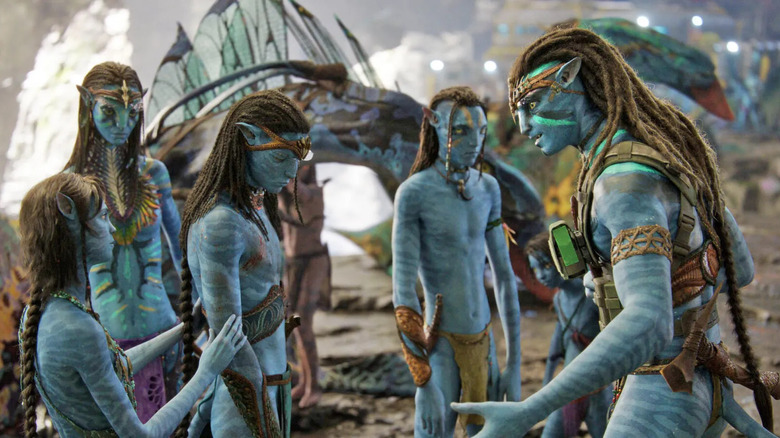How Long Is The Day-Night Cycle On Avatar: The Way Of Water's Pandora?
Astronomers have long held that one of the reasons the Earth has been able to support life while other planets cannot is due largely to its very particular distance from the Sun. According to an article published by Cornell University in 2015, the Earth could only be from between 0.95 AU to 1.69 AU away from the Sun and still support life, often called the Goldilocks Zone. To remind you of 6th-grade astronomy, 1 AU is about 93 million miles. Moons throughout the solar system, however, also might have the possibility of supporting life thanks to their warm atmospheres and the presence of water. Europa, one of Jupiter's largest moons, seems like the most likely candidate for hosting life, followed by Saturn's Enceladus.
The actual astronomy of Pandora, the setting of James Cameron's "Avatar: The Way of Water" is never explicitly laid out in the films, and there isn't a lot of time spent in stellar cartography. What audiences do know is that Pandora is a very Earth-like moon, orbiting a gas giant, that can support a large variety of life, including the Na'Vi. Many of the animals are sentient, as is a living network of psychic roots that seem to stretch down to the center of the planet. Humans can't breathe the air on Pandora, though.
The climax of "The Way of Water" is a massive conflagration between the Na'Vi and the interloping human Marines and whalers that would kill the plant as soon as look at it. The fight begins at dusk, lasts all night, and resolves just as the sun is rising. Appropriately, the characters never talk about "sundown," but instead talk about "eclipse." Pandora is not turning away from the sun, but the moon is orbiting its gas giant so that the sun is obscured.
Pandora is in Alpha Centauri
How big is the sun that Pandora sees, what is the gas giant it orbits, and how fast does Pandora move? Let's examine.
There is a real-life heavenly body called Pandora, incidentally, but it is an icy, potato-shaped moon that orbits Saturn. The Pandora of "Avatar," according to expanded universe lore, orbits the fictional planet Polyphemus, a gas giant that, in turn, orbits around Alpha Centauri A, a.k.a Rigil Kentaurus, one of three real-life stars in a three-star system. Alpha Centauri A and B are a binary system, and A is slightly larger than our sun, and about 1.5 times brighter. It is classified as a G-type star, also called a yellow dwarf. At last count, no planets have yet been detected in the system. It would take five straight years of observation to see if planets pass in front of, or affect the gravity, of the Alpha stars.
To date, most of the planets that have been detected are called "Hot Jupiters," in that they are enormous gas giants that orbit terribly close to their suns. Any Earth-like planets haven't yet been observed. Judging by that gauge, then, one might postulate that Polyphemus would orbit terribly close to Rigil Kantaurus. Whenever the sun is seen in "Avatar," however, it looks to be about as big as ours, leading one to believe that Polyphemus is about 1 AU away from its sun. "The Hot Jupiters," incidentally, would be an excellent name for a ska band.
The fight scene in "The Way of Water" lasts through the night, but doesn't seem to take very long. Indeed, a little bit of thought will reveal that it might not be dark on Pandora very often.
The length of a day on Pandora
Polyphemus, orbits Alpha Centauri A. Alpha Centauri B, however, being a smaller star, also orbits around Alpha Centauri A. Because of its constant proximity to two suns, Pandora would seemingly receive light almost year round. According to facts extrapolated from various fan sites, Pandora's nights, remain light for about half of its year. Also, it seems that Pandora has a high axial tilt of 29°, making for a complicated and wild timing schedule when it comes to days and nights. There doesn't seem to be an actual timed calendar when it comes to mapping days and hours. The Na'Vi seem to be able to roll with the planet's cycles, however, and they do know precisely when the sun(s) will be obscured; the Na'Vi children know they have to be in bed by nightfall/eclipse.
The actual length of a year or a day on Pandora, then, is hard to gauge. It can be said that there are definitely nights that last no more than 100 Earth minutes on Pandora. As taken from an online "Avatar" wiki: "Polyphemus occasionally eclipses Alpha Centauri B at night for about one hundred minutes, but the light reflected by the planet still keeps the night from being dark." Take wikis with a grain of salt, however.
It seems that the nighttime climax of "The Way of Water," then, was not much longer than two episodes of "Star Trek." Given that the final sequence takes as long as it does, then there may not be much cinematic time compression at play. The final sequence of "The Way of Water" could very well be happening in real-time.


